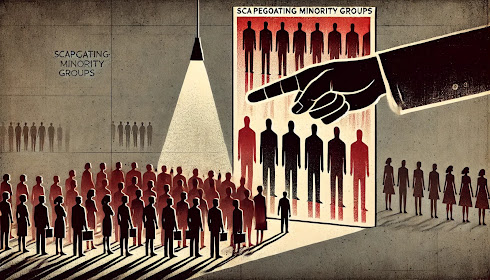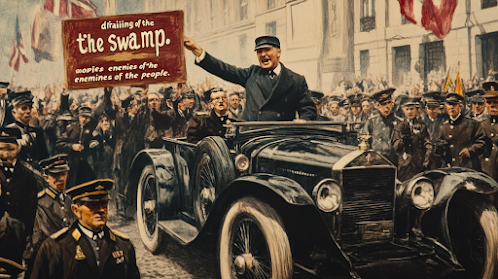The Echoes of History: Trump, Hitler, and the Rise of a New Oligarchy By Claude D. Rhodes, Investigative Reporter
The Echoes of History:
Trump, Hitler, and the Rise of a New Oligarchy
By Claude D. Rhodes, Investigative Reporter
As newly elected President Donald J. Trump returns to the White House for a second, non-consecutive term, his rhetoric and actions have drawn comparisons to historical figures who exploited national grievances to rise to prominence. Chief among these comparisons is Adolf Hitler’s early political career—marked by the use of populism, racial scapegoating, and attacks on democratic institutions to consolidate power.
While history does not repeat itself exactly, patterns emerge that are difficult to ignore. Like Hitler in post-World War I Germany, Trump has cultivated a base of disillusioned citizens, turned minority groups into political scapegoats, vilified democratic institutions, and aligned himself with powerful financial elites who stand to benefit from his leadership. Among those oligarchs is billionaire Elon Musk, whose social media empire has become a haven for right-wing extremism and disinformation.
The following analysis examines the unsettling similarities between Trump’s rise and Hitler’s early years, focusing on the political tactics rather than the eventual outcomes, which remain unknown.
A Playbook Repeating Itself?
Trump’s rise shares notable parallels. His 2016 campaign was built on the idea that America was in decline, that its government had failed the people, and that only he could restore the nation’s greatness. He painted the political establishment as corrupt, repeatedly calling for the “draining of the swamp.” His 2024 campaign doubled down on this message, now branding his opponents as “enemies of the people” and portraying himself as the sole force standing between America and its destruction.
Scapegoating Minority Groups
Hitler’s Strategy:
One of Hitler’s most infamous tactics was the use of racial scapegoating. He blamed Germany’s economic problems on Jews, communists, and other minority groups, portraying them as enemies of the state. His propaganda machine systematically dehumanized these groups, paving the way for extreme policies.
Trump’s Strategy:
Trump has long engaged in similar tactics. His 2018 remark about “shithole countries” reflected his racialized view of immigration, questioning why America accepted migrants from African and Caribbean nations instead of predominantly white countries like Norway. His administration implemented policies such as the Muslim travel ban and family separation at the U.S.-Mexico border, reinforcing the notion that certain racial and ethnic groups were undesirable.
In his 2024 campaign, Trump renewed his anti-immigrant rhetoric, promising mass deportations and targeting asylum seekers, further aligning with nationalist policies that echo historical precedents.
Turning the People Against the Government
Hitler’s Strategy:
Hitler’s rise was marked by relentless attacks on the legitimacy of Germany’s democratic institutions. He portrayed the Weimar government as weak, corrupt, and infiltrated by foreign influences. His failed 1923 coup, the Beer Hall Putsch, was an early attempt to seize power by force. Although he was imprisoned, he used the trial as a platform to spread his ideology.
Trump’s Strategy:
Trump’s approach has followed a similar trajectory. His refusal to accept the results of the 2020 election culminated in the January 6th insurrection, where his supporters stormed the Capitol in an attempt to overturn the results. Following his defeat, he spent years undermining trust in the electoral process, preparing his base for a comeback.
In his second term, Trump has openly challenged institutions like the Department of Justice and the FBI, calling them part of a “deep state” conspiracy. His return to power has further emboldened his followers, with many believing they are engaged in a struggle against an illegitimate system.
Elon Musk: Trump’s Oligarch and the Rise of Tech-Backed Nationalism
Hitler’s Strategy:
In the early 1930s, Hitler secured the backing of industrialists like Fritz Thyssen, who saw his movement as a safeguard against socialism and a means to protect their wealth. Nazi Germany was deeply intertwined with corporate interests, using economic power to fuel political ambitions.
Trump’s Strategy:
Trump has relied on billionaire allies, with Elon Musk emerging as one of the most influential. Since acquiring Twitter (now X), Musk has turned the platform into a breeding ground for right-wing extremism, reinstating previously banned figures and amplifying conspiracy theories.
Public appearances by Musk have raised further concerns, as he has been seen making gestures associated with far-right movements. While Musk denies any ideological alignment, his platform continues to be a powerful tool for nationalist rhetoric, echoing the way early Nazi propaganda manipulated mass communication.
Musk is not alone. Trump’s administration and campaign have been deeply connected to oligarchic interests, appointing billionaires and corporate executives to key positions while shaping policies that disproportionately benefit the wealthy.
Weaponizing Media and Propaganda
Hitler’s Strategy:
Under Joseph Goebbels, the Nazi Party mastered propaganda, using newspapers, radio, and public rallies to shape public perception. Control over the media allowed Hitler to manipulate narratives and silence opposition.
Trump’s Strategy:
Trump has harnessed modern media in an unprecedented way. His unfiltered communication through social media, particularly Twitter (now X), allowed him to bypass traditional news outlets and speak directly to his base. Even after his 2021 social media bans, platforms like Truth Social and X enabled his return, giving him an unregulated space to spread his message.
Fox News and other right-wing networks have functioned similarly to state-run media, consistently reinforcing Trump’s narratives. His campaign has also used AI-generated content to manipulate videos and images, creating a new frontier of digital propaganda.
The Warning Signs Are There—Will We Heed Them?
The early days of Hitler’s rise were dismissed by many as alarmist speculation. Few believed that a fringe political figure could dismantle Germany’s democracy and reshape the world order. Yet, step by step, he eroded institutions, manipulated public sentiment, and consolidated power.
Trump’s trajectory is not identical, but the patterns are undeniable. He has built a movement centered on grievance, turned racial scapegoating into policy, undermined democracy, aligned with billionaires who amplify his message, and encouraged hostility toward the very institutions that check his power.
Now, as newly elected President Trump embarks on his second term, the nation stands at a crossroads. The warning signs are flashing. The question is: will history once again complete its rhyme?








Comments
Post a Comment